OSP Fiber Optic
Transmission Systems
Jump To:
Sources for Fiber Optic Transmitters
Detectors for Fiber Optic Receivers
Wavelength Division Multiplexing (WDM)
Signal Regernators
Fiber Optic Network Transmission Bands
Datalink Performance
Datalinks
A fiber optic datalink is a communications subsystem
that connects inputs and outputs (I/O) from electronic
subsystems and transmits those signals over optical
fiber. In this function, a fiber optic datalink operates
as an alternative to copper cabling or a wireless
subsystem. In typical applications, a fiber optic
datalink acts as a communications medium attached to
electronics on either end that provide the other
services necessary for communications over the link. In
the OSI (Open Systems Interconnection) Network Model,
the datalink is basically the first layer, called the
Physical Layer or PHY.
A
fiber optic datalink consists of fiber optic
transceivers or individual transmitters and receivers
at either end that transmit over optical fibers.
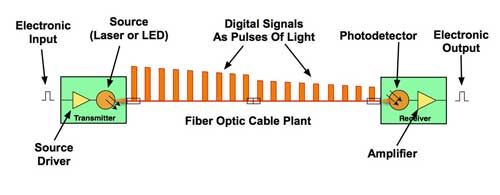
In operation, the fiber optic datalink gets an
electrical pulse input from an electronic system. In
the transmitter, a source driver sends current through
a source, typically a laser but sometimes a LED, which
creates a pulse of light. The pulse of light from the
source is coupled into an optical fiber that is part
of a fiber optic cable plant.

The pulse travels down the fiber where it is
attenuated by the fiber and suffers loss from fiber
joints created by splices or connections. At the
receiver, the light pulse is converted to an
electrical pulse by a photodetector, amplified by the
receiver circuitry and converted to an electrical
pulse compatible with the communications equipment it
connects.
Signals and Protocols
Fiber optic datalinks may transmit signals that
are either analog or digital and of many different,
usually standardized, protocols, depending on the
communications system(s) it supports. Datalinks may be
protocol transparent but may also include data encoding
to provide more robust data communications. Datalinks
may be specified by the application or standardized
network (e.g. Ethernet) they are intended to support or
by the types and bandwidth of signals they are designed
to transmit.

A
fiber optic datalink consists of fiber optic
transceivers or individual transmitters and receivers at
either end that transmit over optical fibers. The
typical datalink transmits over two fibers for full
duplex links, one fiber in each direction. The fibers
may be of any type, multimode (graded index or step
index) or singlemode.
Some links may use couplers and wavelength-division
multiplexing to transmit bi-directionally over a single
fiber as in FTTH PONs passive optical networks or OLANs,
optical LANs. Some links may allow transmission at
several wavelengths of light simultaneously over a
single fiber in each direction, called wavelength-division
multiplexing.

Most
systems use a "transceiver" which includes both
transmission and receiver in a single module. The
transmitter takes an electrical input and converts it to
an optical output from a laser diode or LED. The light
from the transmitter is coupled into the fiber with a
connector and is transmitted through the fiber optic cable
plant. The light from the end of the fiber is coupled to a
receiver where a detector converts the light into an
electrical signal which is then conditioned properly for
use by the receiving equipment.
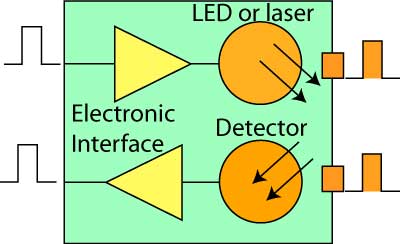
Fiber Optic Transceiver
As
the use of links at 100Gb/s or more become common,
datalinks become more complex. Above about 25Gb/s,
the average limit for direct modulation of typical laser
sources, wavelength division multiplexing, parallel
optics and coherent fiber optic systems are used. In
addition coherent systems can be more effective to
overcome dispersion in long links. Read
more about coherent fiber optic systems.
Analog or Digital
Analog signals are continuously variable signals where the
information in the signal is contained in the amplitude of
the signal over time. Some video signals over fiber
including CATV are primarily analog. Most data
transmission is digital. Analog data transitted as digital
signals are sampled at regular time intervals and the
amplitude converted to digital bytes so the information is
a digital number transmittted as binary bits. Analog
signals are the natural form of most data, but are subject
to degradation by noise in the transmission system. As an
analog signal is attenuated in a cable, the signal
to noise ratio becomes worse so the quality of the signal
degrades. Digital signals can be transmitted long
distances without degradation as the signal is less
sensitive to noise.

Fiber optic datalinks can be either analog or digital in
nature, although most are digital since most data today is
the product of computers and digital by nature. Both have
some common critical parameters and some major
differences. For both, the optical loss margin or power
budget is most important. This is determined by connecting
the link up with an adjustable attenuator in the cable
plant and varying the loss between transmitter and
receiver until one can generate the curve shown above.
Analog datalinks will be tested for signal to noise ratio
to determine link margin, while digital links use bit
error rate as a measure of performance. Both links require
testing over the full bandwidth specified for operation,
but most data links are now specified for a specific
network application, like AM CATV or RGB color monitors
for analog links and SONET, Ethernet or Fibre Channel for
digital links.
Sources for Fiber Optic
Transmitters
The sources used for fiber optic transmitters need to meet
several criteria: it has to be at the correct wavelength,
be able to be modulated fast enough to transmit data and
be efficiently coupled into fiber.
Four types of sources are commonly used, LEDs, fabry-perot
(FP) lasers, distributed feedback (DFB) lasers and
vertical cavity surface-emitting lasers (VCSELs). All
convert electrical signals into optical signals, but are
otherwise quite different devices. All three are tiny
semiconductor devices (chips). LEDs and VCSELs are
fabricated on semiconductor wafers such that they emit
light from the surface of the chip, while f-p lasers emit
from the side of the chip from a laser cavity created in
the middle of the chip.
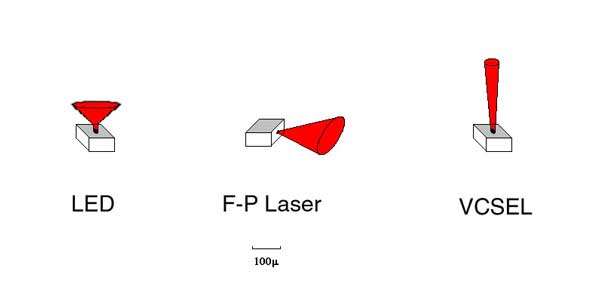
LEDs have much lower power outputs than lasers and their
larger, diverging light output pattern makes them
harder to couple into fibers, limiting them to use with
multimode fibers. Laser have smaller tighter light outputs
and are easily coupled to singlemode fibers, making them
ideal for long distance high speed links. LEDs have much
less bandwidth than lasers and are limited to systems
operating up to about 250 MHz or around 200 Mb/s. Lasers
have very high bandwidth capability, most being useful to
well over 10 GHz or 10 Gb/s.
Because of their fabrication methods, LEDs and VCSELs are
cheap to make. Lasers are more expensive because creating
the laser cavity inside the device is more difficult, the
chip must be separated from the semiconductor wafer and
each end coated before the laser can even be tested to see
if its good.
Typical Fiber Optic
Source Specifications
| Device
Type |
Wavelength
(nm) |
Power
into
Fiber (dBm) |
Bandwidth |
Fiber
Types |
| LED |
850,
1300 |
-30 to -10 |
<250
MHz |
MM |
| Fabry-Perot
Laser |
850,
1310 (1280-1330) 1550 (1480-1650) |
0
to +10 |
>10
GHz |
MM,
SM |
| DFB
Laser |
1550
(1480-1650) |
0
to +25 |
>10
GHz |
SM |
| VCSEL |
850 |
-10
to 0 |
>10
GHz |
MM |
LEDs have a limited bandwidth while all types of lasers
are very fast. Another big difference between LEDs
and both types of lasers is the spectral output. LEDs have
a very broad spectral output which causes them to suffer
chromatic dispersion in fiber, while lasers have a narrow
spectral output that suffers very little chromatic
dispersion. DFB lasers, which are used in long distance
and DWDM
systems, have the narrowest spectral width which minimizes
chromatic dispersion on the longest links. DFB lasers are
also highly linear (that is the light output directly
follows the electrical input) so they can be used as
sources in AM CATV systems.
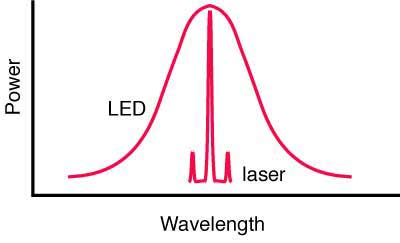
The choice of these devices is determined mainly by speed
and fiber compatibility issues. As many premises
systems using multimode fiber have exceeded bit rates of 1
Gb/s, lasers (mostly VCSELs) have replaced LEDs.
The output of the LED is very broad but lasers are
very focused, and the sources will have very different
modal fill in the fibers. The restricted launch of the
VCSEL (or any laser) makes the effective bandwidth of the
fiber higher, but laser-optimized fiber, usually OM3, is
the choice for lasers.
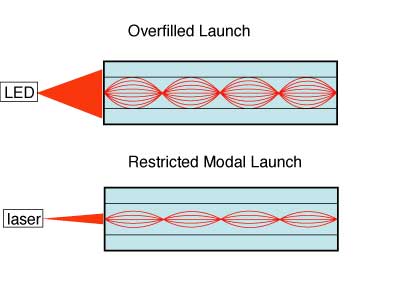
The electronics for a transmitter are simple. They convert
an incoming pulse (voltage) into a precise current pulse
to drive the source. Lasers generally are biased with a
low DC current and modulated above that bias current to
maximize speed.
Detectors for Fiber Optic
Receivers
Receivers use semiconductor detectors (photodiodes or
photodetectors) to convert optical signals to electrical
signals. Silicon photodiodes are used for short
wavelength links (650 for POF and 850 for glass MM fiber).
Long wavelength systems usually use InGaAs (indium gallium
arsenide) detectors as they have lower noise than
germanium which allows for more sensitive receivers.
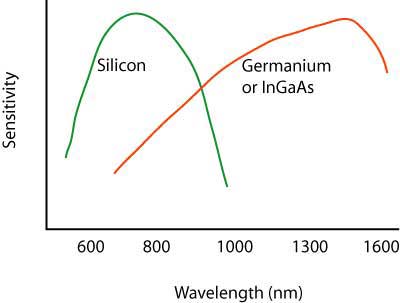
Very high speed systems sometimes use avalanche
photodiodes (APDs) that are biased at high voltage to
create gain in the photodiode. These devices are more
expensive and more complicated to use but offer
significant gains in performance.
Packaging
Transcivers are usually packaged in industry standard
packages like these XFP modules for gigabit datalinks(L)
and Xenpak (R). The XFP modules connect to a duplex LC
connector on the optical end and a standard electrical
interface on the other end. The Xenpak are for 10 gigabit
networks but use SC duplex connection. Both are similar to
media converters
but are powered from the equipment they are built into.
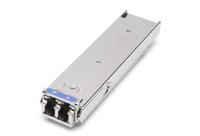
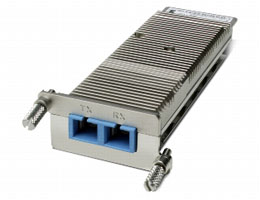
Performance
Just as with copper wire or radio transmission, the
performance of the fiber optic data link can be determined
by how well the reconverted electrical signal out of the
receiver matches the input to the transmitter. The
discussion of performance on datalinks applies directly to
transceivers which supply the optical to electrical
conversion.
Every manufacturer of transcivers specifies their product
for receiver sensitivity (perhaps a minimum power
required) and minimum power coupled into the fiber from
the source. Those specifications will end up being the
datalink specifications on the final product used in the
field.
Wavelength Division
Multiplexing (WDM)
Why Is WDM Used?
With the exponential growth in communications, caused
mainly by the wide acceptance of the Internet, many
carriers are finding that their estimates of fiber needs
have been highly underestimated. Although most cables
included many spare fibers when installed, this growth has
used many of them and new capacity is needed. Three
methods exist for expanding capacity: 1) installing more
cables, 2) increasing system bitrate to multiplex more
signals or 3) wavelength division multiplexing.
Installing more cables will be the preferred method in
many cases, especially in metropolitan areas, since fiber
has become incredibly inexpensive and installation methods
more efficient (like mass fusion splicing.) But if conduit
space is not available or major construction is necessary,
this may not be the most cost effective.
Increasing system bitrate may not prove cost effective
either. Many systems are already running at SONET OC-48
rates (2.5 GB/s) and upgrading to OC-192 (10 GB/s) is
expensive, requires changing out all the electronics in a
network, and adds 4 times the capacity, more than may be
necessary.
The third alternative, wavelength division multiplexing
(WDM), has proven more cost effective in many instances.
It allows using current electronics and current fibers,
but simply shares fibers by transmitting different
channels at different wavelengths (colors) of light.
Systems that already use fiber optic amplifiers as
repeaters also do not require upgrading for most WDM
systems.
How Does WDM Work?
It is easy to understand WDM. Consider the fact that you
can see many different colors of light - reg, green,
yellow, blue, etc. all at once. The colors are transmitted
through the air together and may mix, but they can be
easily separated using a simple device like a prism, just
like we separate the "white" light from the sun into a
spectrum of colors with the prism.

Separating a beam of light into its colors
This technique was first demonstrated with optical fiber
in the early 80s when telco fiber optic links still used
multimode fiber. Light at 850 nm and 1300 nm was injected
into the fiber at one end using a simple fused coupler. At
the far end of the fiber, another coupler split the light
into two fibers, one sent to a silicon detector more
sensitive to 850 nm and one to a germanium or InGaAs
detector more sensitive to 1300 nm. Filters removed the
unwanted wavelengths, so each detector then was able to
receive only the signal intended for it.
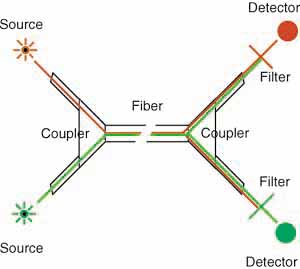
WDM with couplers and filters
By the late 80s, all telecom links were singlemode fiber,
and coupler manufactures learned how to make fused
couplers that could separate 1300nm and 1550 nm signals
adequately to allow WDM with simple, inexpensive
components. However, these had limited usefulness, as
fiber was designed differently for 1300nm and 1550 nm, due
to the dispersion characteristics of glass. Fiber
optimized at 1300 nm was used for local loop links, while
long haul and submarine cables used dispersion-shifted
fiber optimized for performance at 1550 nm. This simple
version of WDM is widely used in fiber to the home (FTTH)
applications. Signals are sent downstream to the
subscriber at 1490 nm (and 1550 for analog CATV if used)
and upstream at 1310 n.
With the advent of fiber optic amplifiers for repeaters in
the late 80s (see below), emphasis shifted to the 1550 nm
transmission band. WDM only made sense if the multiplexed
wavelengths were in the region of the fiber amplifiers
operating range of 1520 to 1560 nm. It was not long before
WDM equipment was able to put 4 signals into this band,
with wavelengths about 10 nm apart.
The input end of a WDM system is really quite simple. It
is a simple coupler that combines all the inputs into one
output fiber. These have been available for many years,
offering 2, 4, 8, 16, 32 or even 64 inputs. It is the
demultiplexer that is the difficult component to make.
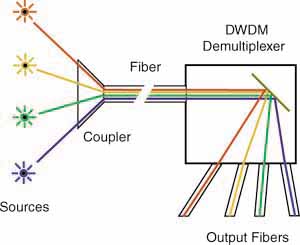
WDM demultiplexer
The demultiplexer takes the input fiber and collimates the
light into a narrow, parallel beam of light. It shines on
a grating (a mirror like device that works like a prism,
similar to the data side of a CD) which separates the
light into the different wavelengths by sending them off
at different angles. Optics capture each wavelength and
focuses it into a fiber, creating separate outputs for
each separate wavelength of light.
DWDM
Current systems offer from 4 to 32 channels of
wavelengths. The higher numbers of wavelengths has lead to
the name Dense Wavelength Division Multiplexing or DWDM.
The technical requirement is only that the lasers be of
very specific wavelengths and the wavelengths are very
stable, and the DWDM demultiplexers capable of
distinguishing each wavelength without crosstalk.
CWDM
Coarse wavelength-division multiplexing is another variant
of WDM. Generally CWDM refers to using lasers spaced 20 nm
apart over the full range of 1260 to 1670 nm. It only
works on low water peak fibers, where the high water
absorption bands have been eliminated in the manufacture
of the fiber.
Advantages of WDM
A WDM system has some features that make them very
useable. Each wavelength can be from a normal link, for
example a OC-48 link, so you do not obsolete most of your
current equipment. You merely need laser transmitterss
chosen for wavelengths that match the WDM demultiplexer to
make sure each channel is properly decoded at the
receiving end.
If you use an OC-48 SONET input, you can have 4X2.5 GB/s =
10 GB/s up to 32 X 2.5 GB/s = 80 GB/s. While 32 channels
are the maximum today, future enhancements are expected to
offer 80-128 channels!
And you are not limited to SONET, you can use Gigabit
Ethernet for example, or you can mix and match SONET and
Gigabit Ethernet or any other digital signals! You can
even mix in analog channels like CATV, as is done
with BPON FTTH systems.
Signal Regenerators
Repeaters
Another technology that facilitates DWDM is the
development of fiber optic amplifiers for use as
repeaters. They can amplify numerous wavelengths of light
simultaneously, as long as all are in the wavelength range
of the FO amplifier. They work best in the range of
1520-1560 nm, so most DWDM systems are designed for that
range. Now that fiber has been made with less effect from
the OH absorption bands at 1400 nm and 1600 nm, the
possible range of DWDM has broadened considerably.
Technology needs development for wider range fiber
amplifiers to take advantage of the new fibers.
Fiber Amplifiers
While the low loss of optical fiber allows signals to
travel hundreds of kilometers, extremely long haul lines
and submarine cables require regenerators or repeaters to
amplify the signal periodically. In the beginning,
repeaters basically consisted of a receiver followed by a
transmitter. The incoming signal was converted from a
light signal to an electrical signal by a receiver,
cleaned up to remove as much noise as possible, then was
retransmitted by another laser transmitter.

Electronic Repeater
Electronic
repeaters added noise to the signal, consumed much power
and were complicated, which means they were a source of
failure. They also had to be made for the specific bit
rate of transmission and upgrading required replacing all
the repeaters, a really difficult task in an undersea
cable!
Since the 1960s, researchers knew how to make fiber
lasers. Proper doping of the fiber (introducing small
amounts of active elements into the glass fiber) allowed
it to be pumped with external light sources until
stimulated emission occurred. While making fiber
amplifiers was hypothesized early in the stages of fiber
optic development, it was not until 1987 that working
models were realized. Major contributors to the
development included Bell Labs and NTT.
The typical fiber amplifier works in the 1550 nm band and
consists of a length of fiber doped with Erbium pumped
with a laser at 980. The pump laser supplies the energy
for the amplifier, while the incoming signal stimulates
emission as the pulse passes through the doped fiber. The
stimulated emission stimulates more emission, so there is
a rapid, exponential growth of photons in the doped fiber.
Gains of >40 dB (10,000X) are possible with power
outputs >+20 dBm (100 mW).
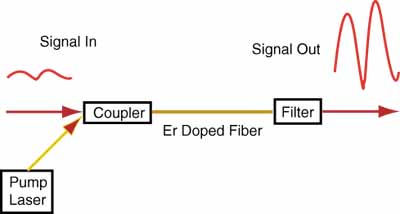
Basic Fiber Amplifier
To date, the most efficient fiber amplifiers have been
Erbium-Doped Fiber Amplifiers (EDFAs) operating in the
1550 nm range. Since most systems still work at 1310 nm,
considerable research has been done to find materials that
would work in this range. Praseodymium-doped fluoride
fiber amplifiers (PDFFAs) using fibers made from zirconium
fluoride or hafnium fluoride have shown some promise, but
have not developed the performance needed for widespread
applications.
The basic structure of an EDFA is very simple. The
amplifier itself emits light energy in a signal wavelength
(usually about 1540nm) using energy supplied to it by
photons in a pump wavelength (usually 980nm) when
stimulated by incoming photons in the signal - the signal
which needs amplification. Just like in a laser, the
emitted photons then stimulate other emissions, so there
is an exponential growth of photons. Supporting the
amplifier is a pump laser, which supplies the amplifier's
energy, a coupler, which combines the pump laser beams and
the signal laser beam and puts them on a single fiber, and
an optical filter, which removes the remaining traces of
the pump beam so that it doesn't interfere with reception
of the signal.
Alternative Designs
The simple diagram of an EDFA shown above is not the only
way EDFAs can be made. Pumping can be done in a forward
direction as shown, backward from the output end or in
both directions. Optical isolators are commonly used at
both ends of the EDFA to prevent pump energy from escaping
back down the fiber or unwanted reflections that may
affect laser stability. Filters, often Bragg gratings
(filters fabricated in fibers), are used to flatten the
gain over the broadest wavelength range for use in WDM
systems.
- Other
Applications
- Besides
being used as repeaters, fiber amplifiers are used to
increase signal level for CATV systems, which require
high power levels at the receiver to maintain adequate
signal to noise performance, allowing longer cable
runs or using splitters to "broadcast" a single signal
through a coupler to many fibers, saving the cost of
additional transmitters. In telephony, they combine
with DWDM (dense wavelength division multiplexers) to
overcome the inefficiencies of DWDMs for long haul
transmission.
Future Developments
Fiber amplifiers continue to be developed to support Dense
Wavelength Division Multiplexing and to expand to the
other wavelength bands supported by fiber optics. Now that
fiber manufacturers have all but removed the water bands
from the spectrum, there is now a range of 1260 to 1610 nm
available for use. Fiber amplifiers and diode lasers will
probably be developed within this band to completely fill
it with useable bandwidth.
Applications
Two obvious applications are already in use, submarine
cables and extending the lifetime of cables where all
fibers are being used. For submarine cables, DWDM enhances
the capacity without adding fibers, which create larger
cables and bulkier and more complicated repeaters. Adding
service in areas where cables are now full is another good
application.
But this technology may also reduce the cost on all
land-based long distance communications links and new
technology may lead to totally new network architectures.
Further Enhancements
Imagine an all-optical network that uses DWDM, switches
signals in the optical domain without converting signals
to electronics, and can add or drop signals by inserting
or withdrawing wavelengths at will. All this is being
researched right now, and given the speed with which
optical technology advances, an all-optical network may
not be far in the future!
Fiber Optic Network
Optical Wavelength Transmission Bands
As fiber optic networks have developed for longer
distances, higher speeds and wavelength-division
multiplexing (WDM), fibers have been used in new
wavelength ranges, now called "bands," where fiber and
transmission equipment can operate more efficiently.
Singlemode fiber transmission began in the "O-band" just
above the cutoff wavelength of the SM fiber developed to
take advantage of the lower loss of the glass fiber at
longer wavelengths and availablility of 1310 nm diode
lasers. (Originally SM fibers were developed for 850 nm
lasers where the fiber core was about half what it is for
today's conventional SM fiber (5 microns as opposed to 8-9
microns at 1310 nm.)
To take advantage of the lower loss at 1550 nm, fiber was
developed for the C-band. As links became longer and fiber
amplifiers began being used instead of
optical-to-electronic-to-optical repeaters, the C-band
became more important. With the advent of DWDM (dense
wavelength-division multiplexing) which allowed multiple
signals to share a single fiber, use of this band was
expanded. Development of new fiber amplifiers (Raman and
thullium-doped) promise to expand DWDM upward to the
L-band.
Since the fiber manufacturers have been able to reduce the
water peaks at 1244 and 1383 nm to very low levels,
several low-cost versions of WDM are in use, generally
referred to as Coarse WDM or CWDM. Most do not work over
long distances so do not require amplification, broading
the wavelength choice. The most popular is FTTH PON
systems, sending signals downstream to users at 1490 nm
and using low cost 1310 nm transmission upstream. Early
PON systems also use 1550 downstream for TV, but that is
being replaced by IPTV on the downstream digital signal at
1490 nm. Other systems use a combination of S, C and L
bands to carry signals because of the lower attenuation of
the fiber. Some systems even use lasers at 20 nm spacings
over the complete range of 1260 to 1660 nm but only with
low water peak fibers.
Manufacturers have been able to make fiber with low-water
peaks, opening up a new transmission band (E-band), but
it has not yet proven useful except for CWDM. It is
probably mostly useful as an extension of the O-band but
few applications have been proposed and it is very
energy-intensive for manufacture.
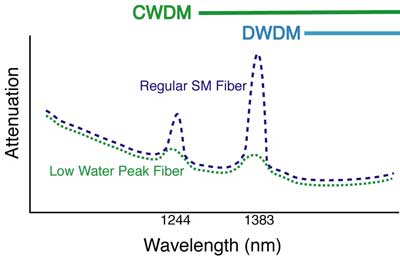
Low Water Peak Fiber
Wavelength Bands Used For
Fiber Optic Transmission Systems
| Band
Name |
Wavelengths |
Description |
| O-band |
1260 – 1360 nm |
Original
band, PON upstream, low end of CWDM systems |
| E-band |
1360 – 1460 nm |
Water
peak band |
| S-band |
1460 – 1530 nm |
PON
downstream |
| C-band |
1530 – 1565 nm |
Lowest
attenuation, original DWDM band, compatible with
fiber amplifiers, CATV |
| L-band |
1565 – 1625 nm |
Low
attenuation, expanded DWDM band |
| U-band |
1625 – 1675 nm |
|
|
|
|
Datalink Performance
Just as with copper wire or radio transmission, the
performance of the fiber optic data link can be determined
by how well the reconverted electrical signal out of the
receiver matches the input to the transmitter.

The ability of any fiber optic system to transmit data
ultimately depends on the optical power at the receiver as
shown above, which shows the data link bit error rate as a
function of optical power at the receiver. (BER is the
inverse of signal-to-noise ratio, e.g. high BER means poor
signal to noise ratio.) Either too little or too
much power will cause high bit error rates. Too much
power, and the receiver amplifier saturates, too little
and noise becomes a problem as it interferes with the
signal. This receiver power depends on two basic factors:
how much power is launched into the fiber by the
transmitter and how much is lost by attenuation in the
optical fiber cable plant that connects the transmitter
and receiver.

The optical power budget of the link is determined by two
factors, the sensitivity of the receiver, which is
determined by the factors shown above and is quantified in
the bit error rate curve above and the output power of the
transmitter into the fiber. The minimum power level that
produces an acceptable bit error rate determines the
sensitivity the receiver. The power from the transmitter
coupled into the optical fiber determines the transmitted
power. The difference between these two power levels
determines the loss margin (power budget) of the link.
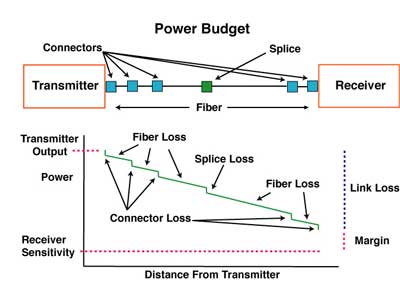
High speed links like gigabit or 10gigabit Ethernet LANs
on multimode fiber have derating factors for the bandwidth
of fiber caused by dispersion spreading out the data
pulse. Older 62.5/125 OM1 fiber will generally operate
only on shorter links while links on 50/125 OM3
laser-optimized fiber will go the longest distance. Even
long distance singlemode fiber links may have limitations
caused by chromatic or polarization-mode dispersion.
If the link is designed to operate at differing bit rates,
it is necessary to generate the performance curve for each
bit-rate. Since the total power in the signal is a
function of pulse width and pulse width will vary with
bit-rate (higher bit-rates means shorter pulses), the
receiver sensitivity will degrade at higher bit-rates.
Every manufacturer of datalinks components and systems
specifies their link for receiver sensitivity (perhaps a
minimum power required) and minimum power coupled into the
fiber from the source. Typical values for these parameters
are shown in the table below. In order for a manufacturer
or system designer to test them properly, it is necessary
to know the test conditions. For data link components,
that includes input data frequency or bitrate and duty
cycle, power supply voltages and the type of fiber coupled
to the source. For systems, it will be the diagnostic
software needed by the system.
Cable Plant Performance
Parameters
The
factors that determine the required performance
parameters for a fiber optic datalink are those that
define the communications signals to be carried on the
link (the data bitrate (digital transmission) or
bandwidth (analog transmission) at which the link
operates), the length of the link and the specifications
(bandwidth and optical loss) of the fiber optic cable
plant. These factors determine the types of transceivers
and cable plant components that must be chosen for a
communications system.
The two major factors of concern in link design and
testing after installation are the loss of the cable
plant and the bandwidth.
Cable
Plant Loss
The loss of the cable plant is determined by the summation
of the loss in the cable plant due to fiber attenuation,
splice loss and connector loss. In some cases the fiber
attenuation may be increased by improper installation of
the cable. As a signal travels down the fiber, the signal
will be attenuated by the optical fiber and reduced by the
loss in connectors and splices.

Figure 6. Loss of signal by attenuation in the cable plant

Loss Budgets
For
each cable plant designed, one must calculate a loss
budget. The loss budget estimates the loss of the fiber
in the cable plant by multiplying the length (km) by the
attenuation coefficient (dB/km), then adding the loss
from connectors and/or splices determined by the number
of connectors and/or splices times the estimated loss
each to get the total estimated loss of the cable plant.
The cable plant loss budget must be lower than the power
budget of the link transceivers (see below) for the link
to work properly.
Dispersion
Dispersion
or pulse spreading limits the bandwidth of the link.
Transceivers have some dispersion caused by the
limitations of the electronics and electro-optical
components but most of the dispersion comes from the
limited bandwidth of the fiber in the cable plant.

Figure 7. Dispersion of signal in the cable plant

Dispersion in multimode optical fiber occurs by modal
dispersion or chromatic dispersion. Modal dispersion is
caused by the different velocities of the various modes
being transmitted in the fiber. Chromatic dispersion is
caused by the different velocities of light at different
wavelengths.
Singlemode fiber also causes dispersion, but generally
only in very long links. Chromatic dispersion has the
same cause as multimode fiber, the differences in the
speed of light at different wavelengths. Singlemode
fiber may also suffer from polarization-mode dispersion
causes by the different speeds of polarized light in the
fibers.
The transceiver must be chosen to provide proper
performance for the communications system’s requirements
for bandwidth or bitrate and to provide an optical
transmitter output of sufficient power and receiver of
adequate sensitivity to operate over the optical loss
caused by the cable plant of the communications system.
The difference in the transmitter output and receiver
sensitivity defines the optical power budget of the
link.
The cable plant components, optical fiber, splices and
connectors, are chosen to allow sufficient distance and
bandwidth performance with the transceivers to meet the
communications system’s optical power budget
requirements. The power budget of the link defines the
maximum loss budget for the cable plant. The maximum
link length will be determined by the power budget and
loss budget for low bit rate links that will be derated
for dispersion for higher bandwidth links.
Most standardized communications systems will specify
the performance of the components including interfaces
to the electronic I/O and types of fiber supported for
various distances. Systems standards may also include
specifications for fiber optic connector type, primarily
at the transceiver. Most communications systems with
short links have options for both multimode and
singlemode fiber while longer links use only singlemode
fiber. All networks may provide guidance as to the types
or grades of fiber needed to support certain
applications.
Every manufacturer of datalinks components and systems
specifies their link for receiver sensitivity (perhaps a
minimum power required) and minimum power coupled into
the fiber from the source. Typical values for these
parameters are shown in the table below. In order for a
manufacturer or system designer to test them properly,
it is necessary to know the test conditions. For data
link components, that includes input data frequency or
bitrate and duty cycle, power supply voltages and the
type of fiber coupled to the source. For systems, it
will be the diagnostic software needed by the system.
Typical Fiber optic
link/system performance parameters
| Link
type |
Source/Fiber
Type |
Wave-
length
(nm)
|
Transmit
Power (dBm) |
Receiver
Sen- sitivity (dBm) |
Margin
(dB) |
| Telecom |
laser/SM |
1300/1550 |
+3 to -6 |
-30 to -45 |
30 to 40 |
|
DWDM |
1550 |
+20 to
0 |
-30 to -45 |
40 to 50 |
| Datacom |
LED/VCSEL |
850 |
-3 to -15 |
-15 to -30 |
3 to
25 |
|
LED/laser |
1300 |
-0 to -20 |
-15 to -30 |
10 to 25 |
| CATV(AM) |
laser/SM |
1300/1550 |
+10 to 0 |
0 to -10 |
10 to 20 |
Within the world of datacommunications links and networks,
there are many vendor-specific fiber optic systems, but
there are also a number of industry standard networks such
as Ethernet which have fiber optic standards. These
networks have agreed upon specifications common to all
manufacturers' products to insure interoperability. This
page in FOA Tech Topics shows a summary of
specifications for many of these systems.
Long Distance
Considerations
Fiber optic links can now be hundreds or even thousands of
kilometers long and operate at 100 gigabits per second or
more – certainly lots more in the future – and at many
wavelengths over a single fiber. Problems that are
insignificant on short or metropolitan links may become
extremely important on long links. The section
on optical fiber will cover topics like chromatic
dispersion, polarization mode dispersion and spectral
attenuation that can be important in these long links.
In links over about 25Gb/s, the average limit for direct
modulation of typical laser sources. coherent fiber optic
systems are use. In addition coherent systems can be more
effective to overcome dispersion in long links. Read
more about coherent fiber optic systems.
Summary
Datalinks must have proper receiver power, neither too
little nor too much, for proper operation.
The link margin can be measured with a power meter and
variable attenuator.
Test Your
Comprehension
Table of Contents: The FOA
Reference Guide To Fiber Optics
|

